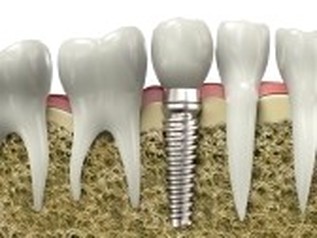
Implants:
Dental implants are artificial tooth replacements that were first developed half a century ago by a Swedish scientist named Per-Ingvar Branemark. Implants arose from the patient’s need to secure loose-fitting dentures. Since the advent of the implant, engineering and enhancements to the implant have enabled dentists to expand the implant’s usefulness, including the replacement of missing or lost teeth. Today, implant techniques provide a wide range of tooth replacement solutions including:
§ Single Tooth Replacement
§ Anterior Replacement
§ Posterior Replacement
§ Full Upper Replacement
Types of Implants There are three main types of implants:
§ The root implant
§ The plate form implant
§ The subperiosteal implant
The root implant—by far, the most popular—is the most effective because it mirrors the size and shape of a patient’s natural tooth. This implant is often as strong as the patient’s original tooth. The implant or artificial root is placed into the jawbone under local anesthesia, then allowed to heal and integrate with the bone. Once the healing process is completed and the jawbone is attached to the implant, the patient returns to the dental office where the implant is fitted with the new tooth. This process generally takes anywhere from three to eight months.
The plate form implant is ideal in situations where the jawbone is not wide enough to properly support a root implant. The plate form implant is long and thin, unlike the root implant, and anchors into thin jawbones. It is inserted the same way as a root implant. In certain cases, the plate form implant is immediately fitted with the restoration without waiting for the healing process to run its course.
The subperiosteal implant is used when the jawbone has receded to the point where it can no longer support a permanent implant.
Dental implants are artificial tooth replacements that were first developed half a century ago by a Swedish scientist named Per-Ingvar Branemark. Implants arose from the patient’s need to secure loose-fitting dentures. Since the advent of the implant, engineering and enhancements to the implant have enabled dentists to expand the implant’s usefulness, including the replacement of missing or lost teeth. Today, implant techniques provide a wide range of tooth replacement solutions including:
§ Single Tooth Replacement
§ Anterior Replacement
§ Posterior Replacement
§ Full Upper Replacement
Types of Implants There are three main types of implants:
§ The root implant
§ The plate form implant
§ The subperiosteal implant
The root implant—by far, the most popular—is the most effective because it mirrors the size and shape of a patient’s natural tooth. This implant is often as strong as the patient’s original tooth. The implant or artificial root is placed into the jawbone under local anesthesia, then allowed to heal and integrate with the bone. Once the healing process is completed and the jawbone is attached to the implant, the patient returns to the dental office where the implant is fitted with the new tooth. This process generally takes anywhere from three to eight months.
The plate form implant is ideal in situations where the jawbone is not wide enough to properly support a root implant. The plate form implant is long and thin, unlike the root implant, and anchors into thin jawbones. It is inserted the same way as a root implant. In certain cases, the plate form implant is immediately fitted with the restoration without waiting for the healing process to run its course.
The subperiosteal implant is used when the jawbone has receded to the point where it can no longer support a permanent implant.
